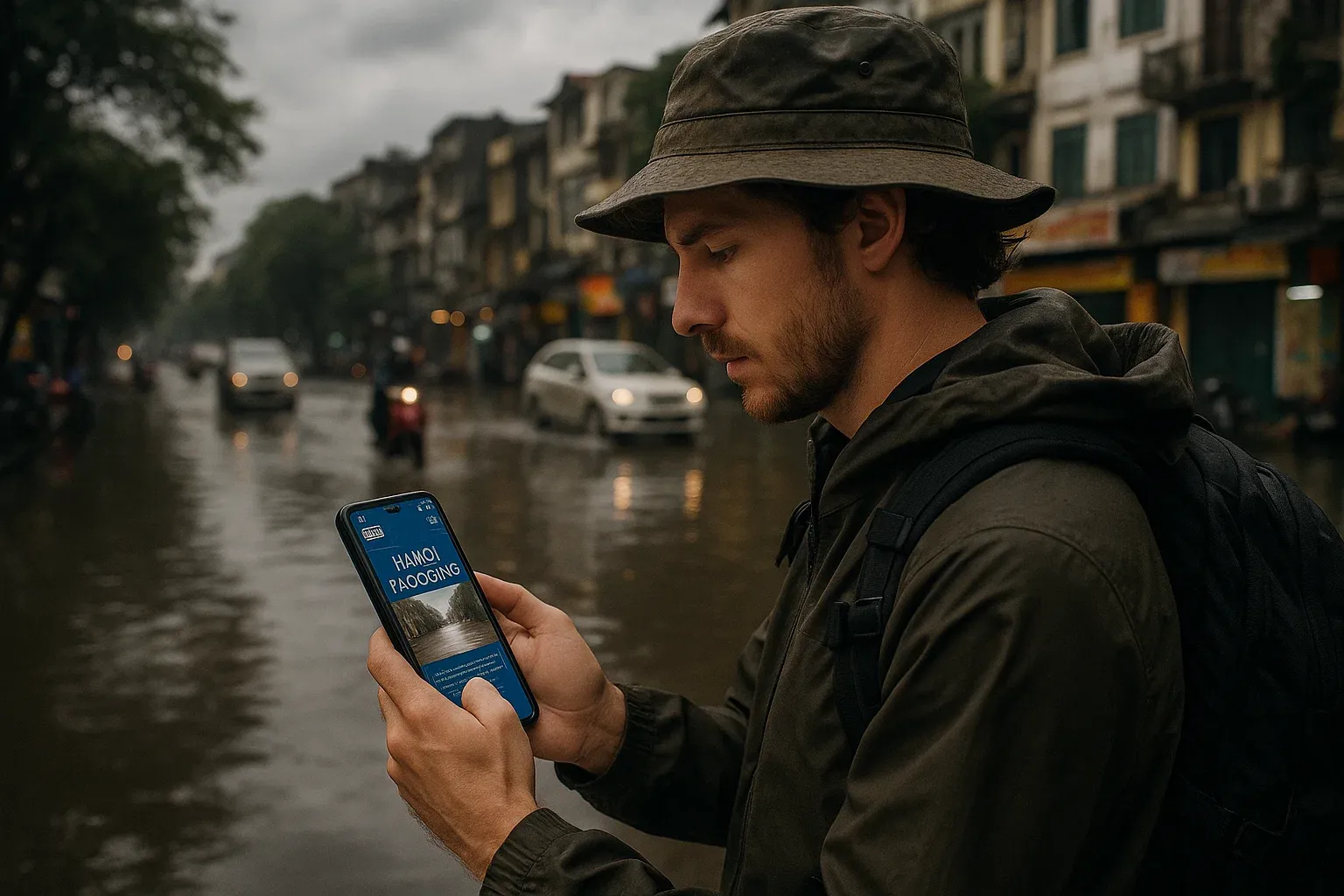If you’re traveling in Vietnam during the rainy season, having reliable mobile data isn’t just convenient—it’s essential for safety. An eSIM ensures you stay connected to alerts, maps, and emergency contacts, even during sudden floods or transport delays.
Travel confidently this season. Get your Vietnam eSIM today and stay online wherever you go, from Hanoi to Ho Chi Minh City.

Why Connectivity Matters for Vietnam Travel Safety
Vietnam’s wet season, typically from May to October, often brings heavy rains and flash floods—especially in the northern and central regions. Even urban areas like Hanoi and Da Nang can experience sudden waterlogging that disrupts transport, power, and communication networks. During these times, having fast and reliable internet access is critical to receive safety updates and stay in touch with others.
That’s where an eSIM comes in. If you’re wondering what is an eSIM card, it’s a digital SIM built into your phone that lets you activate a mobile data plan instantly, without swapping physical cards. It’s the simplest and safest way to stay connected—especially when traditional SIM shops close or networks get overloaded during bad weather.
Using an eSIM for Vietnam provides several travel safety benefits:
- Stay informed with live weather alerts and road closures.
- Access online maps when rerouting during heavy rain.
- Keep in contact with hotels, guides, or local authorities.
- Avoid roaming interruptions during emergencies.
- Receive flood or evacuation updates instantly via mobile notifications.
In short, your eSIM isn’t just a convenience—it’s your lifeline for safe and informed travel across Vietnam.
How eSIMs Help in Vietnam Flood Situations
When floods hit, communication is often one of the first things disrupted. Mobile shops and Wi-Fi networks can go offline, leaving travelers disconnected. An eSIM gives you an advantage—it automatically connects to the strongest available network, even if one provider is down.
For example, travelers using eSIMs in Hanoi have reported being able to access Vietnam Meteorological and Hydrological Administration warnings in real time and reroute travel safely during monsoon delays. The same applies in central Vietnam, where sudden storms can affect major roads connecting Da Nang, Hue, and Hoi An.
By having a data plan Vietnam through your eSIM, you can:
- Use Google Maps or Grab to find dry routes or alternative transport.
- Check local travel advisories through government or embassy sites.
- Contact your family or insurance provider immediately if stranded.
- Book new accommodations or flights online if plans change.
This level of flexibility is what makes an eSIM one of the smartest travel essentials for anyone visiting Vietnam, particularly during unpredictable weather seasons.
Step-by-Step: How to Set Up Your Vietnam eSIM
If you’re preparing for your Vietnam trip, setting up your eSIM only takes a few minutes. Here’s how to do it safely before departure.
1. Check Device Compatibility
Ensure your phone supports eSIM. Most recent iPhones (XS and later), Samsung Galaxy (S20 and newer), and Google Pixel devices already have built-in eSIM capability. Check your settings under Mobile Data → Add eSIM.
2. Pick the Right Plan
Choose an eSIM that offers national or regional coverage. For instance, a Vietnam eSIM from Yoho Mobile connects you to top carriers across major cities, while a Southeast Asia eSIM is great if you’re visiting multiple countries in the region.
3. Purchase Online
Buy your eSIM before you travel. Once your payment is complete, you’ll receive a QR code via email—no waiting in lines or dealing with local shops during a storm.
4. Install and Activate
Scan the QR code in your phone settings to install the plan. Within minutes, you’ll have full access to mobile data—no need for a physical SIM.
5. Turn On Data Roaming
This step ensures your phone connects automatically to the best network. Don’t worry—this uses your local eSIM plan, not your home carrier’s roaming services.

Why eSIMs Beat Traditional SIM Cards During Emergencies
When disaster strikes, convenience becomes survival. Traditional SIM cards depend on physical availability and single-network access, both of which are risky during floods or emergencies.
Here’s how an eSIM compares:
| Feature | Local SIM Card | eSIM for Vietnam |
|---|---|---|
| Setup | Requires shop visit | Online activation |
| Network | One carrier only | Connects to multiple carriers |
| Availability | May close during floods | Always available digitally |
| Durability | Physical risk (lost or damaged) | Embedded in device |
| Flexibility | Must replace when changing plans | Easily switch or top up |
During crises, every minute matters. With an eSIM, you avoid network downtime and maintain access to critical communication tools—navigation, safety alerts, and contact with your embassy.
Travelers who experienced flooding in central Vietnam in 2023 noted that while many lost Wi-Fi access, those using eSIMs could still use mobile data to navigate and find open routes. It’s a small investment that can make a big difference.
Need a fast, reliable connection that doesn’t rely on local shops? Explore how Yoho Mobile works and get your eSIM before your trip.
Staying Informed During Vietnam’s Rainy Season
Staying safe in Vietnam starts with staying informed. Here’s how your eSIM keeps you updated when the weather turns unpredictable:
- Monitor local forecasts through real-time apps like Windy or AccuWeather.
- Access embassy updates for travelers via the U.S. and U.K. consular websites.
- Join local community groups on Facebook for flood alerts and advice.
- Use navigation apps to avoid waterlogged streets or closed bridges.
- Stay connected to your accommodation or tour guides for immediate updates.
With a stable internet connection, you’re not just a visitor—you’re an informed traveler who can make quick, confident decisions.
FAQs About eSIMs and Vietnam Travel Safety
Will an eSIM work if one network goes down?
Yes. Your eSIM automatically switches to another available carrier, ensuring continuous data access during outages.
Can I buy an eSIM once I’m already in Vietnam?
Yes, but it’s best to activate it before traveling. That way, you’re covered from the moment you arrive.
Is it safe to use mobile data during floods?
Yes, as long as your phone stays dry and charged. Mobile data is often more reliable than Wi-Fi during storms.
Do I need a local number to use an eSIM?
No. Most eSIMs are data-only. You can still use apps like WhatsApp, Telegram, or Messenger to call or text via the internet.
How do I top up if I run out of data?
Simply go online and add more data directly through your eSIM provider’s site—no physical visit required.
Stay Safe and Connected Across Vietnam
From Hanoi’s rainy streets to Ho Chi Minh City’s busy avenues, a dependable eSIM ensures you’re never offline when it matters most. Reliable communication and access to live data can make the difference between a disrupted trip and a safe, well-informed journey.
Prepare for the unexpected. Get your Yoho Mobile eSIM for Vietnam today and travel through every season with confidence and peace of mind.
